
Hometown Heroes
Waterton Lakes National Park
Canada's participation in the First World War shaped the country and Canadian identity. More than 600,000 Canadians served in the First World War, and more than 60,000 of them lost their lives.
In these Hometown Heroes pages, Parks Canada recognizes those from and associated with Waterton Lakes National Park who served in the war.
After the war ended in 1918, its impact was felt on the development of Canadian institutions, landforms, communities, and individuals. For example, in Waterton, the memory of the war was inscribed on landforms in place names such as Vimy Ridge and the celebration of peace was given symbolic form in the establishment of the world’s first international peace park in 1932.
Here are the biographies of some of the individuals with strong connections to Waterton Lakes National Park who served in the First World War.
George William Knight 1884-1916, killed in action
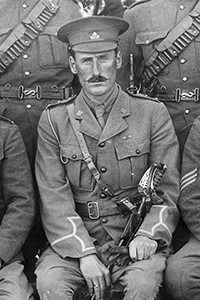 Lieutenant G.W. Knight, 13th Canadian Mounted Rifles, WW1
Lieutenant G.W. Knight, 13th Canadian Mounted Rifles, WW1 Image: Kootenai Brown Pioneer Village
English-born George Knight had all the makings of a fine military officer. He was tall, handsome and had military experience having served for nearly a year in the Boer War with the 2nd London Westminster Imperial Yeomanry Dragoons.
After he immigrated to the Twin Butte area about 1903 to homestead and ranch, he also joined several recreational groups, gaining a reputation for sportsmanship and teamwork, desirable traits for an officer.
Knight had moved to Alberta with two of his younger brothers Herbert and Norman, both of whom also acquired homesteads. He soon joined the 23rd Alberta Rangers, a militia group mobilized in Pincher Creek, maintaining his military connections. As special recognition, he was chosen to represent the Rangers in London during the coronation of George V in 1911.
During the summer of 1914, Knight worked in Waterton Lakes National Park as a fire guard and game warden assigned to the Yarrow Cache cabin. He resigned six months after war was declared to join the 13th Canadian Mounted Rifles with his brothers and other men from throughout Southern Alberta.
With his Boer War and Alberta militia experience taken into account, he was commissioned a lieutenant of his unit. After training in Pincher Creek and then at Sarcee Camp in Calgary, Knight sailed to England. There his unit was broken up to become reinforcements with the Fort Garry Horse in early 1916, just after the Horse was converted to infantry.
On August 3, 1916 Knight was killed instantly by shrapnel after he and seven of his men had completed construction of a trench and were heading back to billets at Bussy-Les-Daours France. His commander noted Knight’s "quiet, cool courage and his unselfish care for his men."
He was buried in the Dantzig Alley British Cemetery near Albert, in northern France. He is honored at memorials in both Twin Butte and Pincher Creek.
Andrew Ford 1890-1951
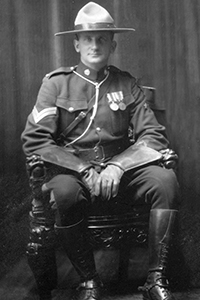 Andrew Ford
Andrew Ford Image: Parks Canada, Foster collection
Police constable Andrew Ford was late entering the war because his services were needed in Canada. Born in England, Ford had immigrated to Canada as a teenager in 1909 and five years later he joined the Royal Northwest Mounted Police (RNWMP) in Vancouver just one month after war was declared.
The federal government, reluctant to release the police from their regular duties because of their critical role in maintaining security at home, relented in April, 1918 because of the need for reinforcements at the front. When a call went out for Mounties who would volunteer to form a unit, some 200 regular members and 500 new recruits responded forming the RNWMP Squadron “A”. Among them was Constable Andrew Ford who became a private.
The men trained briefly at the RNWMP Regina Depot before embarking for England and arrived on June 21, 1918. Ford’s unit became reinforcements to the Canadian Light Horse brigade in October, joining the closing stages of the Battle of Cambrai, France. When the war ended, the Mounties assisted in post war occupation efforts.
After Ford was demobilized in March, 1919 he returned to his former detachment in Fort Macleod and his wife Agnes. That summer, the RNWMP appointed Ford Waterton’s first police constable. In 1924, when the posting became year round, he was put in charge of the detachment and promoted to Corporal. He was the first officer to occupy the new Waterton police facility built in 1928 near the business district.
The Fords and their two daughters integrated completely into the community participating in many activities including school, sports and social events.
A crack shot with a revolver, Ford won six annual police competitions and he taught Waterton’s Boy Scouts how to handle firearms.
In the fall of 1933, after 14 years in Waterton, Ford was promoted to Sergeant and transferred to Banff. He retired in 1942 and died in Calgary in 1951.
Abner Gladstone Virtue 1891-1960
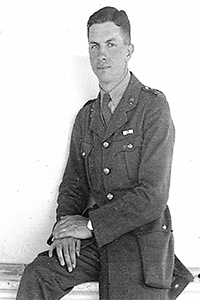 Gladstone Virtue aboard ship returning home, 1919
Gladstone Virtue aboard ship returning home, 1919 Image: Nicolas Virtue
Gladstone Virtue was an achiever his entire life. Born in Ontario, he moved to Lethbridge at the age of ten and by high school showed a flare for writing and public speaking. He studied law at Toronto’s Osgoode Hall, graduating at the top of his class in 1913 from the University of Alberta. His promising law career was just beginning when he joined the military.
Virtue became a member of a Lethbridge militia unit, the 25th Canadian Field Artillery, in August, 1915, spending six months at the Royal Artillery Training School at Kingston, Ontario. The following spring when the 61st Battery was raised in Lethbridge, Virtue enlisted as a lieutenant. The unit trained at Petawawa, Ontario and then in England, spending nearly a year learning the tactics of infantry support. The battery went to the front in the summer of 1917, where it continued to enhance and refine its gunnery techniques even while under fire.
Virtue was awarded the Military Cross for “conspicuous gallantry and coolness” at Bourlon Wood, France on Sept. 27, 1918, keeping the battery in action during heavy fighting. Promoted to Acting Captain, Virtue remained in Europe until June, 1919 during the post-war occupation of Germany and Belgium.
On his way home he stopped in Ontario to marry his beau, Edythe Torrance and arrived in Lethbridge just in time for the Peace Day parade in July, 1919. Virtue resumed his law practice and the couple started a family but Edythe died in 1922 leaving Virtue with two young daughters. In 1925 he married music teacher Marian Ells and introduced her and later, two more children, to Waterton Lakes National Park.
He purchased a park lease in 1941, which remains in the family to this day. Virtue became a King’s Counsel in 1935 and was an active citizen of Lethbridge playing a major role in the city’s development. At the time of his death he was senior partner in the law firm of Virtue, Russell, Morgan and Virtue.
Angus Sutherland Binnie 1895-1933
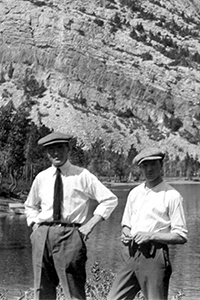 Angus S. Binnie (right)
Angus S. Binnie (right) Image: Parks Canada, Foster collection
Scottish-born “Gus” Binnie called Calgary home for four years, working at successive clerical and accounting jobs, until the 20-year-old answered the call of the newly authorized 82nd Battalion in the fall of 1915.
After six months training in Canada, he sailed to England in May, 1916. Once there, as with many other Canadian units, the 82nd was broken up to provide reinforcements for other battalions already at the front. Like others in his unit Binnie went to France as member of the 10th Canadian Infantry Battalion. The “Fighting Tenth,” which had been formed in 1914, was widely known as one of the best combat units in the field and was involved in every major Canadian action of the war.
Major shrapnel wounds put an end to Private Binnie’s field duty in April, 1917 at the Battle of Arleux in France. After his wounds healed, he was assigned to Bramshott Camp in England where he may have been involved in troop training following completion of a course in that specialty and being promoted to Sergeant.
Following his discharge in April, 1919, Binnie returned to Calgary and then, as a veteran, applied for a civil service job in Waterton Lakes National Park. About 1921, Binnie became office assistant to Park Superintendent George Ace Bevan just as public interest in the park, and resulting paper work, was starting to burgeon.
In his free time, the popular Binnie participated in many local activities including golfing at Waterton’s new course, hiking with members of the Rocky Mountains Club, refereeing at hockey games, attending dances and becoming known for his acting, impersonation and elocution talents.
In 1931, Binnie contracted tuberculosis and sought treatment in a Calgary sanatorium for veterans. Two years later, he succumbed to the disease which was complicated by his war wounds. He left a wife and two children and was buried in the military section of Burnsland Cemetery in Calgary.
Charles Frederick Reilly 1890-1977
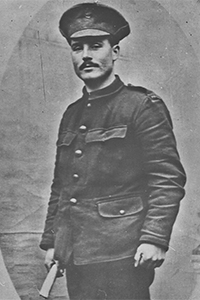 Charles Reilly in uniform
Charles Reilly in uniform Image: John Reilly
When a friend suggested in 1915 that Calgarian Charles Reilly go to Montreal to enlist in the Princess Patricia Canadian Light Infantry (PPCLI), he agreed since he, like other university students in the Canadian Officers Training Corps, was assured a commission.
Desperate for reinforcements, the PPCLI wanted university recruits as a temporary answer to its devastating loss of men earlier in the year at the Second Battle of Ypres. Although Reilly had one more year of studying to complete his engineering degree at the University of Alberta, he joined up.
When Reilly arrived in France in July, 1915 the war seemed quiet. By October he reported he had spent only three days in the trenches. But in September, 1916 things changed dramatically and fighting began in earnest at Somme where he entered the fray.
Like many infantrymen, Reilly contracted trench fever, a widespread flu like condition caused by ever-present lice, requiring hospitalization at Bramshott Camp in England. An ear infection laid him up for an additional period and when he recovered, he was assigned to the newly formed 4th Labour Battalion in France. The battalion was constantly in harm’s way from enemy fire as it constructed roads and bridges and maintained rail lines.
Promoted to Lieutenant as promised, Reilly remained with this unit until he was hit by shrapnel while serving in Ypres, Belgium November 14, 1917. The wound fractured his left leg permanently disabling him. He returned to Canada early 1918.
Once home, Reilly completed his engineering degree and by 1927 added a masters degree in English. In June, 1929, by provincial appointment, he became the first and only year-round police magistrate in Waterton Lakes National Park. As a park resident he was also active in community affairs. But the magistrate’s job ended without warning in 1931 due to budget cuts. He had no choice but to return to Calgary with his wife and growing family where he earned his living teaching school.
Esther Pickering Harland 1889-1988
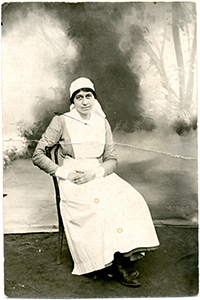 Esther Pickering, WW1 postcard, 1918
Esther Pickering, WW1 postcard, 1918 Image: Dallas Bodnar
When the United States joined the First World War in April, 1917, Esther Pickering wanted to do her bit. The 28-year-old had, to then, led of life of some privilege. Educated at a Boston boarding school, she had both personal and family ties to Harvard and Cambridge society, and was a frequent traveller in part because her parents resided in Jamaica where her father was a well-known astronomer. Esther’s New England lineage was one that went back nearly 300 years, and she was compelled to participate.
In June, 1917 she joined the Volunteer Aid Detachment (VAD) and was accepted by the Harvard Surgical Unit which was working with the British Expeditionary Force in France. The unit was staffed by medical and nursing personnel from Harvard School of Medicine in Massachusetts. As a VAD, Pickering was among a group made up of both trained and untrained personnel who provided assistance to the professional staff by helping tend to the more than 1,000 patients at a hospital at Camiers, France. Esther spent 18 months in this service.
It was likely that the 22nd General Hospital in Camiers was where she chanced to meet a patient named Corporal Murton Harland of Pincher Creek. Harland, a machine gunner with the 13th Canadian Mounted Rifles, had serious shrapnel wounds requiring six months’ hospitalization.
After the war, the pair returned to their respective homes but a year and a half later they were married in Chicago and headed to Harland’s cattle ranch adjacent to the picturesque mountains north of Waterton Lakes National Park. Esther named the ranch Bar X. They made many friends in the region, even hosting A. Y. Jackson, a renowned eastern Canadian painter, himself war veteran, who sketched and at the ranch.
The Harlands retired in 1956, purchasing a summer cabin in Waterton, which was graced with some of Jackson’s paintings, and travelling to warm climes in the winters. They are both buried in the Waterton cemetery.
Harry Northover Reeves 1898-1984
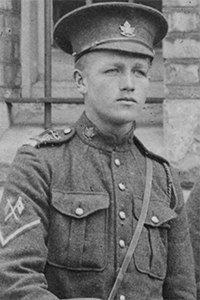 Harry Reeves in uniform
Harry Reeves in uniform Image: Brian Reeves
Harry Reeves enlisted as soon as he could. Just 10 days after turning eighteen, the minimum age without parental consent, he joined the 175th Battalion at Medicine Hat in 1916.
Eight years before, the Reeves’ family had moved to Alberta from Newfoundland to become dry land homesteaders at Carlstadt, Alberta. But like nearly half of those who tried homesteading in Alberta, they failed and were unable to prove up their quarter section. So with two years of experience in the 21st Alberta Hussars, Reeves volunteered to serve.
Initial battalion training took place at Calgary’s Sarcee Camp followed by more extensive training in October in England. Shortly Reeves became a reinforcement with the 31st Infantry Battalion, known as “Bell’s Bulldogs.”
He was sent to France in January, 1917 subsequently seeing action at Vimy Ridge and nearby Lens. During heavy shell fire in July, 1917, Private Reeves experienced heart problems and was later declared medically unfit. He was transferred to the labour pool and was discharged in February, 1919.
On returning to Canada, he applied for a land grant near Killam, Alberta under the Soldiers’ Settlement Act but found that farming wasn’t his strong suit. He was, however, a talented carpenter and painter and plied these trades in Banff and then Waterton Lakes National Park. He took a liking to Waterton and spent the rest of his life in the park, marrying Sybil Kemmis, a local teacher, in 1936. As a wedding present his mother-in-law handed over operation of the Kilmorey Lodge which she owned and he quickly fit into the community.
When a concession was offered to the public in 1946 to build and operate an auto bungalow in the townsite, it was his status as a veteran that cinched the deal. Reeves Cabins became the largest and most successful of four such facilities in the park. The Reeves sold out in late 1959 and built Reeves Corner House, a park souvenir shop. He retired in 1972.
Herbert Knight 1885-1962
 Corporal H. Knight, 13th Canadian Mounted Rifles, WW1
Corporal H. Knight, 13th Canadian Mounted Rifles, WW1 Image: Kootenai Brown Pioneer Village
“Bert” Knight was a man to whom sorrow was no stranger. He lost four members of his family before, during and after the war: his father, his eldest brother, a younger brother and his only son. However, Knight rose to the challenge of making the best of difficult circumstances.
Like many of his fellow countrymen from England, Knight immigrated to southern Alberta to stake a homestead. He and two brothers arrived in the Pincher Creek area in 1903 each choosing homestead land on which to build homes and raise cattle and draft horses. By 1910 they formed Knight Bros. Ranches.
The genial brothers all joined the 23rd Alberta Rangers militia and when the recruitment call came in February, 1915, they all joined the 13th Canadian Mounted Rifles. Following training in Canada, the unit went to England where it was reassigned as infantry reinforcements with the Fort Garry Horse and was sent to the front in France and Belgium.
The battlefield death of his elder brother, Lieutenant George W. Knight, in the summer of 1916 was followed by the 1917 death of his younger brother Lieutenant Norman Knight from peritonitis. Bert Knight transferred to the Royal Scots Fusiliers becoming second lieutenant. He returned to Southern Alberta in 1919 hoping for happier days ahead.
As a veteran, he was hired to fill the post of Chief Park Warden at Waterton in June, 1919 and moved into the Cedar Cabin on the shore of what became known as Knight’s Lake, a name still locally used. It is the only geographical featured ever named for a Waterton park employee.
In 1932 Knight was promoted to park superintendent. During his 20-year career in Waterton he witnessed unprecedented development both in the townsite and also in the greater park area and saw major increases in visitation. He transferred in 1939 to Prince Albert National Park, Saskatchewan, retiring to Victoria 1947. He died there in 1962.
John Alfred Frankish 1887-1969
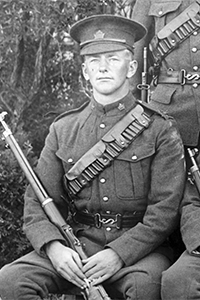 John Frankish, 13th Canadian Mounted Rifles, WW1
John Frankish, 13th Canadian Mounted Rifles, WW1 Image: Kootenai Brown Pioneer Village
When “Jock” Frankish joined the 13th Canadian Mounted Rifles (CMR) in February, 1915 at Pincher Creek, he was among a large number of British immigrants living in Canada to join the war effort.
Frankish was born in Yorkshire, England, not far from the North Sea. He immigrated to Alberta about 1909 and soon settled on a homestead near Fishburn, Alberta. Within a few years, he began working in Blairmore, a booming mining town in the Crowsnest Pass, where he found a position as a butcher with P. Burn’s Meat Packing Plant. It was an occupation that required strength and fitness, which helped him prepare for the first six months’ military training in Alberta.
When his unit arrived in England it was dispersed as infantry reinforcements to the Fort Garry Horse. He went to the front in Feb. 27, 1917 and was gradually promoted from private to sergeant. In April, 1918 following fighting near Bois des Essarts and Rifle Wood, France, he was cited for bravery which earned him the Military Medal along with eleven of his fellow soldiers that day. This medal was awarded to non-commissioned officers and men on the recommendation of the unit’s commander-in-chief in the field.
Frankish returned to southern Alberta by May, 1919. In the spring of 1921, he was appointed seasonal fire and game warden in Waterton Lakes National Park, joining other war veterans employed there within the civil service. That autumn he left the park to become a forest ranger with the Dominion Forest Service.
He married Alice Maud Jenkins, a Twin Butte area nurse, in 1930. Her cousin and his former co-worker, Bo Holroyd, acted as best man. The couple resided near Beaver Mines until he left the Forest Service in 1935.
Frankish returned to the Twin Butte area where he ran a mixed farm and dairy business until the 1950s when the couple moved to White Rock, B.C. and raised poultry. Jock Frankish died in 1969.
John Charles Holroyd 1889-1974
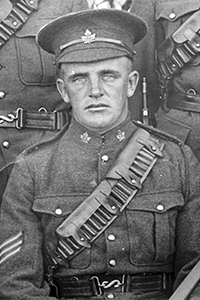 Sergeant J.C. Holroyd, 13th Canadian Mounted Rifles, WW1
Sergeant J.C. Holroyd, 13th Canadian Mounted Rifles, WW1 Image: Kootenai Brown Pioneer Village
“Bo” Holroyd was a fifth generation Prince Edward Islander for whom duty and the honor of public service were a family tradition. Military service was a natural extension of that tradition.
He left the island at age 17 to work on his uncle Harry Jenkins’s ranch near Fishburn, Alberta. About 1909, like many other young men who lived in the area, Holroyd joined the militia serving as a sergeant in the 23rd Alberta Rangers.
Holroyd enlisted in the 13th Mounted Rifles in February, 1915, and although the militia trained briefly each summer, he, and the members of the new unit, had a long way to go before becoming battle ready. The men trained in Canada before going to England, arriving in September, 1915. There the unit was transferred to the unmounted Canadian Cavalry Brigade as reinforcements to the Fort Garry Horse which saw action in Belgium and France.
Almost immediately Private Holroyd was assigned to the Machine Gun Squad which would, over time, prove to be an essential complement to infantry riflemen. Holroyd paid the price, however, with a permanent hearing loss, a temporary sprained shoulder and abrasions which were treated in a military hospital.
Discharged in May, 1919, the 29-year-old returned to the Twin Butte area. Government policy after the war gave hiring preference to veterans and in September, 1920, Holroyd became a warden at Waterton Lakes National Park. Four years later he married Constance Warburton, a Boston trained nurse, who was also from Prince Edward Island. Holroyd spent the first 13 years of his career at the Pass Creek warden’s station and was promoted to Chief Park Warden in 1932.
Holroyd retired in March, 1947. He was the longest serving park warden in Waterton history. He returned to ranching and spent the next 27 years raising both pure bred and commercial cattle on his land near Twin Butte. He died in 1974.
John Edward Pittaway 1879-1954
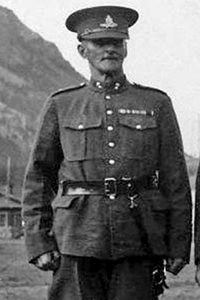 J.E. Pittaway, 39th Battery, Royal Canadian Artillery
J.E. Pittaway, 39th Battery, Royal Canadian Artillery Image: Chris Morrison
“Jack” Pittaway’s self-proclaimed motto was “duty first and last” and he had many years of military service to demonstrate that ideal. Born in Limerick, Ireland, Pittaway enlisted in the Imperial army as a 14-year old trumpeter while Queen Victoria was still on the throne.
Four years later with his formal education completed, he became a non-commissioned officer working his way up to Sergeant Major Warrant Officer second class. During his nearly 27 years serving in the Royal Horse and Royal Field Artillery, he got a firm grasp on both duty and discipline.
Pittaway served in Ireland, Wales, India and Egypt until the beginning of the First World War when he was sent to France as a bombardier in the 26th Battery, Royal Field Artillery. He was wounded in October, 1914 at Ypres when shrapnel penetrated his right lung. At the close of hostilities he was serving with the army of occupation in Egypt and Palestine. He received his discharge April 27, 1920.
He and his wife Mary and three sons, John Jr., Bert, and Denis, left their home in Suffolk, England and moved to Waterton in 1927 just as the park was undergoing an impressive building and tourist boom.
At first he worked as night watchman at the newly opened Prince of Wales Hotel but had to seek a better paying job to support his family. As a veteran, he was hired as seasonal park gardener and then moved on to become the townsite campground caretaker, a position he kept for the next 21 summers. During the winter he took care of the Waterton school and did odd jobs in the townsite.
Prior to the Second World War, he and his sons joined the 39th battery of the Royal Canadian Artillery, a militia unit headquartered in Pincher Creek. When he retired in 1949 he moved to Calgary and served in the Canadian Corps of Commissionaires. He is buried in Burnsland Cemetery.
Margaret Elliot Thomson McNally 1887-1987
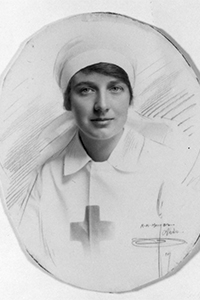 Margaret McNally
Margaret McNally Image: Brenda Ringdahl
A combination of circumstances and choice brought Margaret Thomson to Canada. Born in the North Sea city of Aberdeen, Scotland, she was orphaned as a teenager. She went to live with prosperous relatives, continuing her education but when she was admitted to Cambridge University, her guardian felt she was too young to attend.
After the war began, she became a nurse’s aide, joining the Volunteer Aid Detachment (VAD) in July, 1915. She assisted the Royal Army Medical Corps in the 2nd London Hospital (Chelsea) and then was transferred in 1916 to a military hospital in France. By the end of her service in 1919, she had been awarded the honour of a scarlet efficiency stripe which denoted competence.
VAD members, mostly women, were trained volunteers who assisted professional nursing staff and provided operational support for medical facilities. Their work was administered by the British Red Cross and Order of St. John. By the end of the war, over 90,000 women had registered to serve in the VAD.
During this service, Thomson met her future husband Captain Alfred McNally, a widowed Canadian doctor seconded from the Royal Canadian Surgical Corps to the Royal Army Medical Corps in 1915. McNally was a graduate of the University of Toronto who had established a medical practice in Lethbridge in 1907.
Thomson became his war bride in 1919 at Leeds and moved to Lethbridge, a city that could not have been more different from Aberdeen, Scotland. Nonetheless, she adapted well to her new location becoming a homemaker and mother. In 1929 Margaret McNally purchased a cabin in Waterton which three successive generations of McNally descendents have since enjoyed.
Unfortunately Alfred, who had not been well, died in 1935 leaving Margaret to raise their three sons. She encouraged all three to complete their university educations. In 2007 her son, Ed McNally, established a generous memorial nursing scholarship at the University of Lethbridge to honour his mother’s contribution during the war.
Vincent Rawlins 1893-1918, killed in action
Rancher Vincent Rawlins had no idea when he was conscripted to serve in the Canadian Expeditionary Force in 1918 that his days were numbered. Nine years before, Rawlins, then a laborer, had immigrated to Alberta from England to begin a new life joining his parents who had arrived two years before. Rawlins settled in the Twin Butte area presumably to work on his father’s land.
In the spring of 1915 Rawlins took a seasonal job as a fire and game warden in the newly-enlarged Waterton Lakes National Park working on trails and doing routine patrols. When his term ended in November, Rawlins returned to ranching, boarding with his sister and brother-in-law who had land north of the park. In 1917, with the war heating up, casualties mounted just as volunteer numbers were dwindling and there was a desperate need for reinforcements. Conscription was seen as the answer and, although it was a contentious piece of legislation to many, Canada’s Military Service Act was enacted in August, 1917.
In January, 1918 the call up began. Rawlins, fit, young and independent, got his affairs in order and reported to Calgary’s 1st Depot Battalion. He was among some 24,000 men conscripted in Canada, half of whom were British born, who saw duty in France.
Rawlins arrived in England at the end of February where he underwent training. By late May, Rawlins was at the front where his unit became reinforcements for the 10th Canadian Infantry Battalion.
Shortly after the war entered its last 100 days, his battalion reached its objective and consolidated its position near Caix, France. Then on August 8, 1918 at the Battle of Amiens, Private Vincent Rawlins was killed by shrapnel from an enemy airplane bomb. He was among 1,036 Canadians killed in that battle. He is buried in Longueau British Cemetery near Amiens, France, and is remembered locally on the Pincher Creek cenotaph and the Twin Butte memorial.
William Henry Matkin 1896-1971
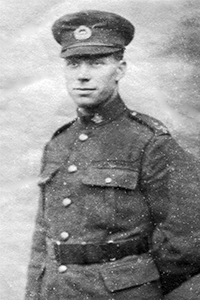 Bill Matkin
Bill Matkin Image: Pat Stanford
Leavitt farm boy William Matkin, eldest son of Cardston pioneers, had no militia experience when he enlisted in the 13th Canadian Mounted Rifles (CMR) in Cardston but in time of war, military service was an obligation of his religious faith as well as a demonstration of commitment to Canada. An early February, 1915 recruitment for the CMR brought together a spirited group of men throughout Southern Alberta.
Training for Matkin’s squadron began at Cardston but he was soon sidelined when he was afflicted with appendicitis and then two highly contagious diseases, influenza and then impetigo. He finally arrived in England in July, 1916, where he was reassigned to the 10th Canadian Infantry Battalion. Upon landing in France, Private Matkin marched right into the Battle of the Somme in which 24,029 Canadians lost their lives.
He was again in the thick of battle at Vimy Ridge where, on April 9, 1917, he was wounded by shrapnel resulting in a compound arm fracture. Later he was diagnosed with a malfunctioning heart. He spent over a year in hospital and convalescence. When he stepped off the train at Cardston in 1919, he was greeted by 300 people and the hometown band who had gathered to welcome him home.
He went to work in Calgary while he awaited the arrival of Alice Koop, whom he had met in England. They married in Calgary and moved to the family farm at Leavitt, about 20 miles east of Waterton Lakes National Park. Matkin was able to find employment as a labourer with the park warden service but resigned in 1934 to take a job as a diamond driller in South Africa leaving his family behind. Alice joined him in 1937, but she fell ill on the way home and was buried at sea never again to see her children waiting in Waterton.
Two years later, William Matkin remarried. In later life he served in the Canadian Corps of Commissionaires. He is buried in the Leavitt cemetery.
Honour Roll: The First World War and Waterton Lakes National Park
All known individuals with strong connections to Waterton Lakes National Park who served in the First World War:
ASHMAN, LeviATKINSON, James Henry
BARNES, Bertram
BEVAN, George Ace
BINNIE, Angus Sutherland
BOWER, Andrew
BRYANT, Frank
CHRISTIANSEN, Ralph Morris
DEVEBER, H. A.
ENERSON, Oscar P.
ENGLISH, Joseph James
FORD, Andrew
FOSTER, Walter
FRANKISH, John Alfred
GAIRNS, Peter
GIDDIE, John M.
GLADSTONE, John Taylor
GLADSTONE, W. (presumably Wallace)
HARLAND, Murton Shore
HARLAND (nee Pickering), Esther
HOLROYD, John Charles
JENKINS, Francis Herbert
JONES, James
KEMMIS, Arthur Charles
KNIGHT, Herbert
KNIGHT, George William*
KNIGHT, Norman
LOUGHEED, Isaac
LeCAPELAIN, Charles King
LYNCH, Dennis
MCALLISTER, Leslie Stewart
MCNALLY, Albert Dr.
MCNALLY, (nee Thomson) Margaret Elliot
MARTIN, Benjamin Bennifer
MATKIN, William Henry
MAUNDER, Frederick Edgar
MILROY, William
MORRIS, Scotty J.
PITTAWAY, John E.
PRESLEY, William James
RAWLINS, Vincent*
REEVES, Harry Northover
REILLY, Charles Frederick
SIMMONS, Ronald Dyke
TIDBALL, Oliver
TOUROND, David Victor
SCOTT, James Carlton
UDELL, Fred
VIRTUE, Abner Gladstone
VROOM, Ralph Ernest
WAGSTAFF, Edward Henry
ZORN, Leonard Christian
*Killed in Action
This Honour Roll includes staff and people with close associations with Waterton Lakes National Park who served in allied forces in the First World War. Further research is required to confirm service of some individuals. Please direct additions or corrections to dylan.frank@pc.gc.ca
War-related place names in Waterton Lakes National Park
During the war years, the Geographic Board (the federal body which was responsible for assigning names in Canada) actively sought out war names. Military officials were asked for information about Canadian generals and ordinary soldiers who had been awarded the Victoria Cross.
The war names used in Waterton are similar to the rest of the Rocky Mountains. There are names related to specific battles (e.g. Avion, Dardanelle, Bosporous, Festubert, Vimy Ridge), there are names commemorating leaders and outstanding figures (e.g. Alderson) and finally, there are names that memorialize individuals (e.g. Carthew).
Many names were applied during the war years. At the time, there were two major surveying and map-making exercises underway in Waterton Lakes National Park. In 1913 and 1914, Waterton was included in a survey of the Crowsnest and Rocky Mountains Forest Reserves, carried out by the Department of the Interior. Morrison Parsons Bridgland and his crew surveyed Waterton in 1914. Nearby, surveying and mapping of the British Columbia-Alberta boundary in the Waterton area was also carried out in 1914 and 1915 by A.O. Wheeler and R.W. Cautley. The resulting maps created a need for place names. As the war went on, several Waterton maps showed war-related names. In fact, the idea of using war-related names was first raised by M.P. Bridgland in 1915 when he was looking for names for peaks in Waterton. As a result, the first war-related name in the Canadian Rockies is Waterton’s Mount Alderson. Names were used to memorialize people and to celebrate successes in the war effort.
Alderson, Mount, Lake and Creek
Named to honour British Lieutenant General Edwin H.A. Alderson, the first commander of the Canadian Expeditionary Forces during the First World War. Alderson led the 1st Canadian Division into its first battles in France in 1915. He is often quoted for telling the Canadians as they moved to the front line that, “My old regiment, the Royal West Kent, has been here since the beginning of the war and it has never lost a trench. The Army says, ‘the West Kents never budge.’ I now belong to you and you belong to me: and before long the Army will say, ‘The Canadians never budge.’” The name was suggested by M.P. Bridgland in June 1915 when he submitted names for features on maps of the Crowsnest and Waterton Lakes Park, Rocky Mountains Forest Reserve.
Festubert Mountain
Named after a village east of La Bassée (France) where Canadian troops fought. Festubert was one of the first major battles on the western front in which Canadian soldiers saw action. The battle was led by Lieutenant General Alderson, as part of the British First Army’s attack on Germans during May 15 to 25, 1915. The Canadians engaged in many frontal attacks but were mowed down by German machine guns. Although the Canadians achieved some of their objectives, the few gains cost the Canadians over 2,400 casualties. Located along the continental divide, the name first appeared on maps produced by the British Columbia-Alberta Boundary Survey in 1917.
Avion Ridge
The Geographic Board, in 1928, stated it was a word ‘applied to any war plane.’ However, in 1931, this assertion was corrected by the Belgian Consul who stated that avion simply meant plane. Others have said that the ridge was named because "its shape resembles that of an aircraft.” This relationship to airplanes is plausible; both airplanes and their use in warfare were new at the time of the First World War.
According to Waterton’s Canon Middleton, Avion was named “after Avion in France which was taken by the Canadians in 1917.” Canadians fought in the area between the village of Avion (north of Vimy) and the City of Lens, France, in May and June 1917. Among the tactics employed were trench raids in which the Canadians advanced, destroyed German trenches, and then retreated.
Carthew, Creek, Lakes and Mount
Named for boundary surveyor, Lt. William Morden Carthew, who surveyed in the Waterton area and later died in the First World War. Carthew was born in the United Kingdom, came to Canada in 1905 at age eighteen, and later trained as a surveyor. Carthew was Alberta Boundary Commissioner, R.W. Cautley’s assistant; surveying Akamina Pass for the Alberta-British Columbia Boundary Commission in 1914. After the season’s work was over, he enlisted and went overseas. He was killed by shell fire at Ypres on the morning of 3 June 1916 “while leading his men in a charge”. In 1916, Cautley wrote to Wheeler asking if he would join him in recommending a peak near Akamina Pass be named for the recently killed surveyor. Carthew had climbed “this particular mountain in order to set Signal for Mr. Cautley.” He was one of five Alberta surveyors lost in the Great War.
Vimy Ridge and Peak
The ridge and peak, formerly Sheep Mountain, were named in 1917 after Vimy Ridge was captured by Canadian soldiers. The Battle of Vimy Ridge was the first battle in which all four Canadian divisions fought together to successfully take and hold an objective which had eluded others since 1914. The successful Canadian attack was the result of meticulous planning, preparations and use of tactical innovations; as well as the courageous and determined actions of the 40,000 Canadian men at the ridge. While the attack is considered a great Canadian victory, the battle was won with tremendous cost with 10,602 Canadian casualties. From the moment the victory was announced, it represented a coming of age of Canada’s evolution from British colony to independent nation.
Vimy has remained important to Canadians, both as a symbol and as a place. In 1922, France granted Canada perpetual use of a 117-hectare section of land at Vimy Ridge for a battlefield park and memorial. Dedicated in 1936, the memorial, designed by Canadian sculptor Walter Seymour Allward, memorializes Canadians killed in the war whose bodies were never identified. Their 11,285 names are carved in the monument. The memorial and surrounding park were designated a National Historic Site in 1997.
In 2003, April 9th was declared a National Day of Remembrance marking the anniversary of the Battle of Vimy Ridge. Vimy Brook was not accepted locally and its previous name “Hell Roaring” Creek was reinstated.
Dardanelles
Named after the narrows leading from the Mediterranean Sea into the Black Sea in Turkey; it was a battle site during the First World War.
Bosporus (the Narrows)
Named after a strait which joins the Black Sea to the Sea of Marmara, separating Europe from Asia Minor. It was a battle site in Turkey during the First World War.
Bear's Hump
The mountain previously known as “ Bear Mountain” was changed to Mount Crandell in 1914 for Edward Henry Crandell, a pioneer Calgary businessman and city councillor who had an interest in the first producing oil well in western Canada, Discovery No. 1 in the Cameron Valley. However, the bear reference survived as the “Bears Hump”, the name for a prominent rounded buttress of the mountain above the Townsite. For some time, the Bear’s Hump was known locally as the “Pimple”. This may have derived from the name given to the north end of Vimy Ridge during the First World War. When this point on Vimy Ridge was taken by the Canadians on April 12 1917, General Edward Hilliam signalled “I am king of the Pimple.” This marked the end of the Battle of Vimy Ridge.
* The Poppy Design is a registered trademark of The Royal Canadian Legion, Dominion Command and is used under licence.
Related links
- Date modified :